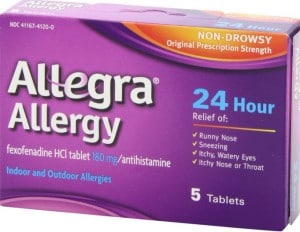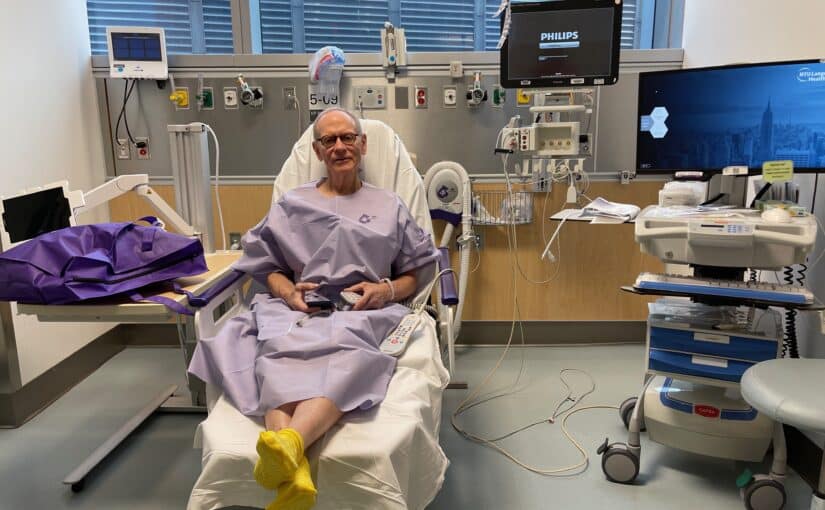Updated October 12, 2020
by Barbara Nevins Taylor
The changing season encouraged us to check up on our post and republish to make sure readers have a chance to find the information.
If you find your eyes itchy and watering, your nose dripping and feel tempted to reach for an antihistamine, you might want to check the side effects, especially if you are an older adult.

While antihistamines work wonders for millions, some find they trigger adverse effects including muscle pain.
I discovered fexofenadine, the active ingredient in Allegra, can cause scary side effects. When the fexofenadine side effects kicked in, I felt extraordinary back and leg pain.
A dermatologist suggested I take Allegra, an over-the-counter antihistamine, to combat seasonal hives. I bought a box of Allegra 24-hour gelcaps, and took one. A few hours later, I had trouble getting up from my desk chair and blamed the stiffness in my hip on too much sitting.

But that night, as I began to make dinner, I felt a hammering muscle pain in my mid-back close to my spine. Every movement I made triggered sharp jabs that seemed like hockey pucks banging the muscles and fibers along the right side of the spinal column.
I abandoned dinner, eased myself on to the floor and rested flat for the evening. Several hours later, the back pain subsided. But I gasped out loud when I stood up. My right hamstring and iliotibial band wouldn’t bend and wouldn’t hold me up. The slightest pressure triggered what felt like hammering in the muscles and joints in the back of my thigh and on the right side of my leg to just above the ankle. When I woke up the next morning, I still couldn’t bend my right leg and pain coursed down the leg and on the outside of the knee.
Nothing I did the day before would have caused the back or leg pain. I get backaches from time to time, but this felt entirely different. I searched my memory for the slightest thing that I did that might have caused it. Taking the one Allegra gelcap stood out.
The package label didn’t suggest that Allegra caused back pain. It says, “Adults and children 12 years of age and over take one 180 mg tablet with water once a day.” It warns, “Adults 65 years of age and older: ask a doctor.”
When I looked up the side effects for Allegra and fexofenadine, back pain, body aches and soreness showed up as “less common” side effects on a number of health websites including the MayoClinic.org, which says back pain, body aches or pain, joint pain, muscle pains or stiffness, pain in arms or legs and difficulty moving can occur as side effects.
The Food and Drug Administration’s (FDA) prescribing information says “clinical studies of Allegra tablets and capsules did not include sufficient numbers of subjects aged 65 years and older to determine whether this population responds differently from younger patients.”
But for a 180 milligram daily dose, the FDA lists back pain as the number three contraindication, experienced by 2.8 percent of the testing group.
So I had information. But eight days later, I still couldn’t bend my right leg and had to sit with it stretched out. I worried about permanent damage and went to see Dr. Andrew Feldman, an orthopedist. He sympathized because he’d experienced contraindications and muscle weakness after taking another drug manufactured by a different company.
He examined me, found nothing broken or torn, and said, “You’ll have to wait until the drug clears your body.” He recommended physical therapy.
The pain subsided, but even with the excellent help of physical therapists at Kima (now Knosis Center for Physiotherapy and Wellness), which offers manual manipulation treatment, the stiffness in my hamstring and behind my knee remained for over three weeks. And even more disturbing, a gushing waterfall of tingling in my right thigh woke me throughout the night. The nerve tingling continued after the other symptoms disappeared, although it eventually calmed down.
Months after I took one Allegra gelcap, Dr. Alfred Ogden, a neurosurgeon at Columbia Presbyterian Medical Center, suggested that the gushing in my thigh may still be a side effect of the drug.
Bottom Line
Dealing with the side effects of Allegra’s fexofenadine, eliminating the pain and muscle stiffness and nerve tingling required doctor visits, physical therapy and a lot of time and money to cure problems I shouldn’t have had. So what about the drug company?
Back at the beginning of it all, in the thick of my discomfort and fury about not being fully informed by the pharmaceutical company, I reached out to the media relations department of Sanofi-Aventis, Allegra’s manufacturer. I posed a series of questions and Heather Levis Guzzi, a senior communications specialist, responded.
Sanofi-Aventis Response
“For the past 15 years, Allegra has been providing allergy sufferers with relief of symptoms from indoor and outdoor allergies. Allegra Allergy is indicated in adults and children 12 years of age and over for temporary relief of the following symptoms due to hay fever or other upper respiratory allergies: runny nose, itchy, watery eyes, sneezing, itching of the nose or throat. Allegra’s label has been approved in accordance with FDA requirements. Contact a physician or pharmacist with questions regarding the content of the Drug Facts.”
After that pro-forma response, I still had questions.
1. Why aren’t the possible side effects of muscle pain, etc. listed in a prominent way?
The side effects listed in the Drug Facts label originate in the prescription label. The entire label undergoes extensive review by FDA before the label is approved as part of the overall switch from prescription to over-the-counter (OTC) status.
2. If a consumer suffers a side effect of muscle and joint point, is there an antidote?
There is no known antidote to antihistamine products.
3. If people over 60 are more likely to have a problem with Allegra, why not mention that?
The Drug Facts label, under “Directions” section, includes a statement to ask a doctor — before taking Allegra – if you are an adult 65 years of age or older.
4. How long should it take to clear the system?
The elimination half-life of Allegra is approximately 14 hours. Therefore, one dose of Allegra would theoretically be eliminated by the 3rd day post-dose in a normal healthy adult.
5. What is the chemical interaction that causes the problem of muscle and joint pain? I looked for research and couldn’t find it.
Back pain and pain in the extremities are reported side effects of fexofenadine. When conducting clinical studies, the drug manufacturer is required to report all side effects, even if the causality is not established and the mechanism is not known.
Follow-up
Almost three months after I complained to Sanofi-Aventis, I received a letter asking me to fill out a pharmacovigiliance consumer questionnaire that will find its way to the FDA. The pharmaceutical company indicated it would query my doctor for this report.
So if you are older, think twice before taking fexofendadine even in the middle of allergy season.




Thank you so much Barbara for writing this piece. After suffering a full month with unexplained & recurring swelling & tenderness in my backbone, fatigue, fatigue in my legs, unexplained muscle pain (and what i describe as tendon pain) mainly in my legs & a disturbing tingling in my legs that kept me up at night, I realized that I started Allegra when these pains started. After 2+ trips to the doctor and my searching for possible complications, i learned that Fexo in Allegra is most likely the culprit (i guess i qualify as having “rare” side effects as well). Your description sounded eerily similar to my experience. Thank you for sharing this and giving me Hope! I’m switching antihistamines today.
Please let us know what works for you!!